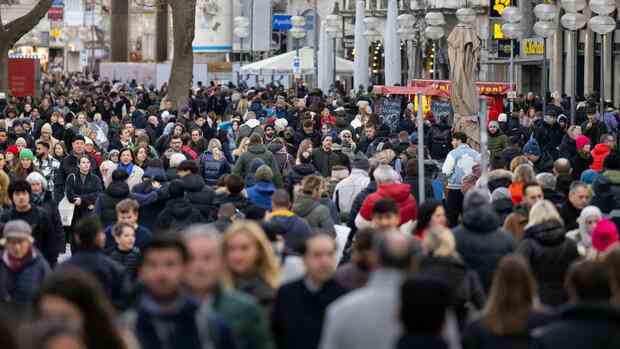Dusseldorf The mood among German consumers improved again at the start of the year. This is signaled by the HDE consumption barometer, which has now risen to 88.54 points for the third month in a row.
The leading indicator is now back at the level of last summer, but the values are still lower than after the outbreak of the corona pandemic in spring 2020. The barometer is calculated monthly by the Handelsblatt Research Institute (HRI) for the HDE trade association; it is based on a representative survey of around 1,600 households. In the past, the index has always fluctuated around the value of 100 and temporarily collapsed in the early days of the corona pandemic.
At the turn of the year, the economic expectations of the consumers surveyed recovered. They rose to their highest level since March 2022; fears of inflation fell to a three-month low, as the details of the consumption barometer show. Concerns about interest rate hikes also receded.
So far, consumers and retailers have weathered the energy price crisis quite well. Private consumption is likely to have risen by around five percent in real terms last year due to the catch-up effects as a result of the pandemic; for 2023 and 2024, the HRI expects growth of 0.5 and 0.8 percent.
Top jobs of the day
Find the best jobs now and
be notified by email.
In real terms, retail probably achieved the second-best result in its history in 2022. Based on data from eleven months, the Federal Statistical Office expects real sales to be 0.3 percent below the record value of the previous year. Not price adjusted, i.e. without taking price developments into account, retailers are expected to generate 8.2 percent more sales in 2022 than in the previous year.
Sales growth in one product group is particularly strong
While trade in everyday products such as food, beverages and tobacco products fell by 4.1 percent in real terms by the end of November, sales of non-food items increased by 2.8 percent in real terms.
The growth in sales of textiles, clothing, shoes and leather goods was particularly strong. Here, retailers increased their real sales by 28.6 percent compared to the same period last year.
The big loser was the mail order and internet trade, which turned over 8.1 percent less in real terms than in 2021. However, these traders had achieved enormous growth during the Corona period; In 2021, real sales in online trading had increased by 12.3 percent.
>> Read here: The retail sector faces a tough year of consolidation
The greatest burden on consumption in the new year remains the high energy prices, the associated inflation and the resulting real wage losses. The HRI assumes an annual average of five percent inflation for 2023 and still three percent for 2024.
Price level has risen by almost 23 percent within five years
Within four years, the price level would have risen by almost 23 percent – previously it took 16 years, from 2005 to 2020, for the price level to rise by a similar amount. In order to balance out these price increases in the economy as a whole, wages would have to rise by around 5.5 percent in all sectors for four years.
Nevertheless, there are first signs of relaxation. Inflation fell to 8.6 percent in December, mainly due to government gas aid. But gas, petrol and heating oil also became significantly cheaper on the world markets.
In addition, the state is trying to cushion the high real wage losses in the short term with amounts in the hundreds of billions. For example, the minimum wage rose sharply in October, and at the turn of the year the new citizens’ allowance and housing benefit plus, which should noticeably increase the disposable income of more than one million households. From March onwards, the electricity and gas price brakes will probably ensure falling energy prices and, together with the onset of base effects, will permanently depress inflation.
Consumers try to compensate for the remaining real income losses by reducing their savings rate or even by liquidating savings in order to be able to maintain their usual level of consumption.
From March, the electricity and gas price brakes will ensure falling energy prices and, together with the onset of base effects, will permanently depress inflation.
(Photo: dpa)
At 9.6 percent, the savings rate in the third quarter was almost a full point lower than in the same period of the previous year, and the HDE consumer barometer also signals a persistently low propensity to save for the fourth quarter; a trend that is likely to continue in 2023.
Economics Minister Robert Habeck does not expect gas prices to fall until the end of 2023. “I hope that it will be better towards the end of 2023, even if not at the level of 2021,” said the Green politician. “We will have to endure higher prices throughout the year.”
More: The loss of prosperity – what the crisis is costing Germany

